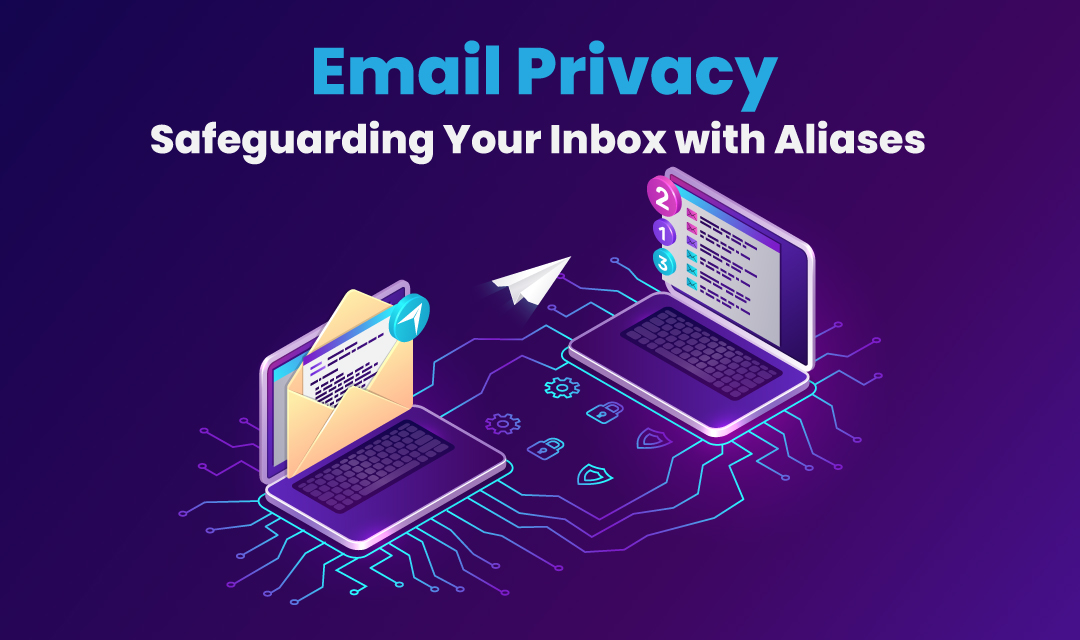
You decide to shop online for a new pair of running shoes and visit a hypothetical online retailer, MyBestRunningShoes.com. On the website, you browse through different shoe options, compare prices, and eventually chose a pair you like. To complete the purchase, the store requires you to enter your email as an identifier, and you created an account with your primary email address.
The online store may have a privacy policy that states they will share your account details with third-party companies to offer you promotional deals which you didn't know at the time of registration. One of the third-party companies, MyBestFashionProducts.dom, sends you a promotional email regarding fashion products that you didn't sign up to receive. Sound familiar? How do you go about safeguarding your email address, so that you have better control over how other companies use your email address?
What is Email Privacy?
Email privacy refers to the protection of personal information and the content of emails from unauthorized access, interception, or disclosure. It is the right of individuals to have their email communications kept private and secure, ensuring that only intended recipients have access to the content of the emails. In addition to protecting your email account, protecting your email address from the hands of spammers and hackers will also protect you from phishing and email spam.
We all know how to protect our email account by creating a strong password, using a 2-factor authentication, and closing our sessions after use on public computers. In this article, we'll discuss how you can protect your email account by using aliases, mail forwarding services, and temporary email accounts.
1. Aliases and Catchall Accounts
Email alias is an email address without having its own inbox, but it merely forwards received email to another email account. A catch-all email address is a mailbox setup that collects all emails arriving at non-existing email addresses for a particular domain. You may set up your primary email address as the catch-all email, or create a brand new email account solely to capture emails destined to the non-existing email address of the domain.
Email Aliases
An email alias is an alternative email address that forwards emails to your primary inbox without actually having a mailbox. You can use aliases when signing up for newsletters, online services, or websites, which allows you to keep your primary email address private. If you start receiving spam or unwanted emails to the alias, you can simply delete it and create a new one.
Every email service provider offers email aliases for each user, some have unlimited aliases while others have a preset limit. For example, Google Workspace allows up to 30 email aliases for each user. Rackspace email doesn't have a hard limit on the number of email addresses you can create on an email account.
Catchall Email
A catch-all email account is a type of email configuration that allows you to receive emails sent to any address within a specific domain that doesn't have an email account setup. In a traditional email setup, you would need to create individual email accounts for each unique email address you want to use. However, with a catch-all email account, you can receive emails sent to any address in the domain without having to create individual accounts for each one.
Here is how a catch-all email account works:
- DNS MX Record setup: In order to receive emails, the domain administrator must configure the email server settings through the domain's DNS control panel. In the DNS settings, set up the MX records for the domain that represents email servers and their priority.
- Wildcard Email Forwarding: The catch-all email account is created by using a "wildcard" email forwarding rule. In the email server's configuration, a wildcard symbol (*) is used to specify that any email sent to the domain, regardless of the specific address part before the "@" symbol, should be forwarded to the catch-all account.
- Receiving Emails: Once the catch-all email account is set up, any email sent to any non-existing address at the domain will be forwarded to the catch-all account.
Advantages of Catch-All Email Account
A catch-all email account allows you to create unique email addresses on the fly without the need to set up individual accounts for each one. This can be useful for testing purposes, managing various departmental or project-related emails, or dealing with temporary situations.
If someone accidentally sends an email to a non-existent address at the domain, a catch-all account ensures that the email is not lost and can still be received and handled.
Disadvantages of Catch-All Email Account
One of the significant drawbacks of using a catch-all email account is that it can become a target for spam. Since any email sent to the domain will be forwarded to the catch-all account, spammers may try various combinations of random addresses at the domain to reach the catch-all account.
Without proper filtering and organization, a catch-all account can quickly become cluttered with emails intended for different recipients, making it challenging to manage effectively. Due to spam concerns, some email providers and administrators may choose not to enable this feature. Instead, they prefer setting up an email alias for each legitimate email address they want to use.
2. Email Forwarding Service
An email forwarding service is a service that allows you to automatically redirect incoming emails from one email address to another. It enables you to receive messages sent to a specific email address and have those emails forwarded to one or more alternative email addresses. This way, you can use the forwarding address for specific purposes, and if you receive an abundance of unwanted emails, you can change the forwarding address without affecting your primary email account.
Email Forwarding Service Providers
There are several email forwarding services available that you can use for this purpose. Some of the popular email forwarding services include:
- AnonAddy: AnonAddy is based on an open-source platform, and it offers free and paid subscription services. It allows you to create a preset number of aliases per your subscription tier, and forward incoming emails to your primary email address. It offers various features such as custom domain support and email filtering.
- SimpleLogin: SimpleLogin is also based on an open-source platform, and it offers free and premium subscription models. It is acquired by ProtonMail in 2022. lets you create aliases on the fly and forward them to your main email. It also offers browser extensions for ease of use and additional security features.
- Forward Email: Forward Email provides email forwarding services with the ability to create aliases and manage them conveniently. It supports custom domains and multiple recipients for forwarded emails.
- Blur (formerly MaskMe): Blur offers email forwarding along with other privacy features like masked credit card numbers and masked phone numbers. It offers free and premium versions and allows you to manage email aliases and forwarded emails.
Before choosing an email forwarding service, ensure that it meets your specific needs and provides the level of privacy and security you require. Review their features, security measures, and user reviews to make an informed decision about choosing the one that meets your need.
3. Temporary Email Service
There are several email providers that offer one-time use or temporary email addresses. These services are often known as "disposable" email providers, and they allow you to create short-term email addresses that are typically valid for a limited time or a limited number of received emails. These temporary email addresses can be useful for situations where you need to provide an email address for a short-term purpose, such as signing up for a service or website that you don't want to use long-term.
Some popular disposable email providers include:
- Temp Mail (temp-mail.org)
- Guerrilla Mail (guerrillamail.com)
- 10 Minute Mail (10minutemail.com)
- Mailinator (mailinator.com)
- Fake Mail Generator (fakemailgenerator.net)
- YOPmail (yopmail.com)
These services typically generate random email addresses for you to use, and the emails received on these addresses are usually accessible for a short period (ranging from a few minutes to a few hours) before they are automatically destructed. Keep in mind that these temporary email addresses should not be used for critical or sensitive communications, as they are not secure and not meant for long-term use.
Conclusion
Protecting your primary email account is essential for privacy and security. Utilize email aliases to create alternative addresses that forward messages to your main account, keeping your primary address safe from spam and data breaches. Catch-all email allows you to receive email messages sent to any address in your domain, ensuring important emails are not lost due to typos. Utilize mail forwarding services to protect your email accounts by creating forwarding addresses that you can dispose of later. Temporary email services offer disposable addresses for short-term use, protecting your main email from spam and unwanted subscriptions. Use these techniques alongside strong email security practices for a secure and efficient email experience.
Share this post
Leave a comment
All comments are moderated. Spammy and bot submitted comments are deleted. Please submit the comments that are helpful to others, and we'll approve your comments. A comment that includes outbound link will only be approved if the content is relevant to the topic, and has some value to our readers.




Comments (0)
No comment